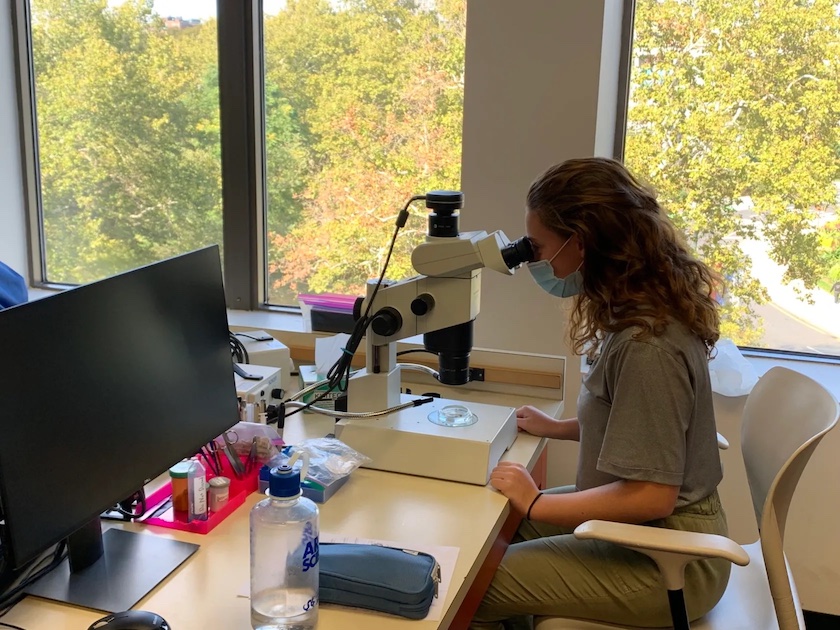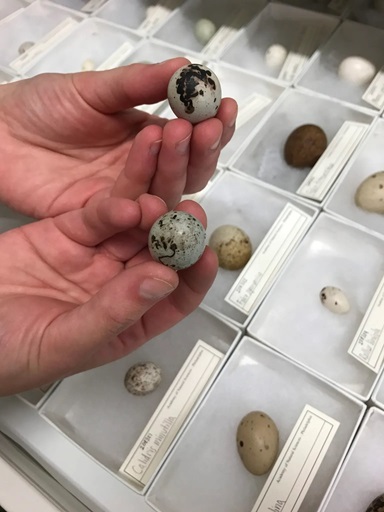A Day in the Life at the Academy of Natural Sciences' Ornithology Department

Environmental science major Abigail Del Grosso is on co-op at the Academy of Natural Sciences
November 18, 2022
A co-op in the Academy of Natural Sciences' ornithology department has allowed environmental science major Abigail Del Grosso to more deeply explore her interest in birds. She shares her more about her experience in the Q&A below, which originally appeared on the
Academy of Natural Sciences blog.
 Del Grosso studies bird eggs in the Academy's collection
Del Grosso studies bird eggs in the Academy's collection
Tell us more about yourself.
I’m a third-year student at Drexel working toward my BS/MS in environmental science. Since starting at Drexel, I’ve had experiences studying both the living and non-living parts of our environment, but I’m most excited by studying birds, their parasites and the coevolution of the two. I’d like to continue this research after I graduate.
I’ve always had a casual interest in birds, but I rediscovered my love for them during lockdown. I think a lot of people can relate to becoming more invested in their local nature during this time. This coincided perfectly with me applying for a co-op position at the Academy’s Ornithology Department, and thankfully I’ve been able to work there as a lab assistant and for my master’s thesis!
What are your daily tasks inside the Ornithology Department?
The biggest project I’ve been working on is our egg collection. Ultimately, I will be rehousing the whole collection and reorganizing it taxonomically. The main bird collection is organized by orders, families and genera of birds. I’ll be doing the same with the eggs. Before I can do that, though, I need to make sure as many egg specimens as possible are fully processed. This means I’ve been identifying and labeling eggs, as well as entering their data into our database.
The oldest specimens I’ve databased have been from the 1840s, so these are very old and fragile eggs. Sometimes their collectors or preparators wrote information like the species name, collection date and location directly onto the egg. Other times I must use field guides and compare unidentified specimens to the rest of the egg collection to determine what kind of bird egg I’m looking at.
I also prepare bird specimens for the collection. I’ve prepared about 70 skins, and some of them have ended up being housed in the collection, which is amazing to me! These skins, if prepared properly, can be used for research for hundreds of years.
Before prepping a bird, I ruffle it for ectoparasites like lice and mites, which I collect. Then I write down data about it, like its weight, if it has molt and the colors of body parts that will fade over time. I separate the body of the bird from the skin and freeze tissue samples that can be used for genetic analysis. I also look inside the body to take notes on how old the bird was, what it was eating and what sex it is. Once the skin is as cleaned out as possible, the bird is stuffed with cotton, sewed shut and left to dry.
I’ve also been mounting bird lice onto microscope slides for deposition into the Academy’s Entomology Collection. These lice were collected from snowy owls in Michigan. I follow a protocol that requires several days and various reagents before the lice can be mounted onto glass microscope slides for viewing. Once the lice are mounted, I use a microscope to identify the species of louse.
This process involves searching through literature and comparing species descriptions to what I have in front of me. However, since most species of bird lice are host-specific, meaning they only infest one or a few kinds of birds, I can narrow down the possibilities. So far I’ve prepared and labeled nearly 300 slides, all of the species Strigiphilus ceblebrachys (Denny 1842).
Why is this work important?
Having specimens prepared and databased properly democratizes science by making them available to researchers around the world, not only in the present, but potentially hundreds of years in the future. Specimens can be used to answer questions about how species have changed over time, how they respond to climate change and how pollution or contamination have affected their environments. Future technologies might be able to use specimens to answer questions we can’t imagine asking.
Additionally, specimens housed in collections may be the last evidence we have that a species existed at a certain place and time, whether because it was locally extirpated or went globally extinct. History has shown that it is possible for even the most abundant birds, like the passenger pigeon, to go extinct. Similarly, specimens of understudied animals like bird lice may be the only vouchers for their existence if they or their hosts die out.